
Things of Interest Around the Roaches
This page contains gossip, information and legend about events that have happened around the Roaches......
- 3500 year old Urn - found on the Roaches during footpath restoration
- Helicopter assisted stone walling - over the top conservation
- Aircraft crashes - there have been a number on the Roaches
- The Cannibals of Caster Bridge - a creepy tale
- The Death of Alice - tragedy in Lud's Church
- Sir Gawain and the Green Knight - Knights on the Roaches
- Private Zoo article in the Leek Post and Times newspaper
- Upper Hulme - an unusual hamlet with a ford
- Meerbrook - a pretty village
- Meerbrook Village Hall - the centre of the local community
- The Fire of Aug 2018 - a devastating fire which threatened homes and burnt 200 acres
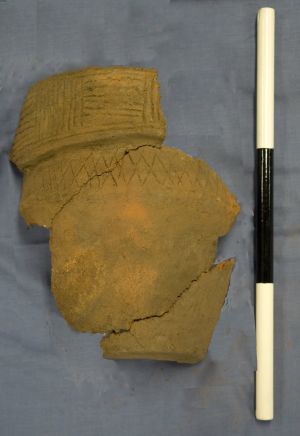 An ancient earthen ware pot, containing cremated human remains has been discovered by a worker repairing a footpath during 2015.The urn, believed to date back about 3500 years, was found on the Roaches by contractor Kieran Fogarty whilst digging a trench to reinforce a popular footpath.
An ancient earthen ware pot, containing cremated human remains has been discovered by a worker repairing a footpath during 2015.The urn, believed to date back about 3500 years, was found on the Roaches by contractor Kieran Fogarty whilst digging a trench to reinforce a popular footpath.
Ken Smith, cultural heritage manager for the Peak District National Park, said: “Kieran did exactly the right thing – by contacting us so quickly we were able to get out to the site and identify what he had uncovered. From the type and style of the pot, and its contents, we identified it as a Bronze Age cremation urn and knew we needed to move quickly to conserve the remains.”
Ken and cultural heritage team colleagues John Barnatt, Sarah Whiteley and volunteer Ann Hall carried out a rescue excavation to gain as much archaeological material and information from the site as possible.
Ken said: “The impression of the urn’s side and base was still clearly visible in the edge of the cremation pit. We were also able to identify the edges of the pit that the urn had been placed in in prehistory – within the fill of this pit was a significant amount of cremated bone and charcoal which we were able to recover fully.We are now looking for funding for post-excavation work so that specialists can study the urn and its contents. Close inspection of the pot fragments may tell us where the clay came from, whilst C14 dating of the charcoal will help us put a date on the cremation. Study of the cremated bone will give an indication of the age, and even the sex, of the individual.”
Once the urn has been investigated it will be deposited with the Potteries Museum at Stoke.
Ken added: “Often finds like this are associated with burial mounds but in this case there was no clue on the ground surface that there was archaeology present. It offers an important reminder that even small scale ground disturbance, such as footpath repair, can have an archaeological impact."
John Barnatt, who led the excavation, said: “The finding of the urn illustrates that people in the Bronze Age also probably appreciated and perhaps venerated this location.”
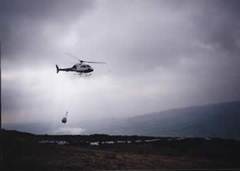 In
Autumn 2004 a helicopter was used
to carry stone from Brownsett farm onto the Roaches to re-build the wall
along the north edge of the wood above Five Clouds.
In
Autumn 2004 a helicopter was used
to carry stone from Brownsett farm onto the Roaches to re-build the wall
along the north edge of the wood above Five Clouds.
The helicopter was used for most of the day doing a round trip in 5 minutes or so. The stone was carried in the type of big bags you see sand delivered in.
This must have cost a fortune especially to rebuild such an obscure
wall. It may have been the classic end of financial year 'spend the budget'
project to which so many organisations succomb. 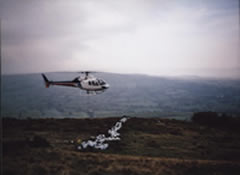 Especially
as the television series 'Dalziel and Pascoe' had just used the Roaches
for an episode and presumably had paid for the privilage.
Especially
as the television series 'Dalziel and Pascoe' had just used the Roaches
for an episode and presumably had paid for the privilage.
Perhaps someone else knows better and would like to enlighten us all. Send me a note if you do. Webmaster
There have been a number of aircraft crashes on the Roaches, most as a result of low cloud and the aircraft flying lower than their flight plan dictated. The book-"'Peakland Air Crashes - the South" by Pat Cunningham details the aircraft involved and the reasons for the crashes.
 If
you travel along the road from the Winking Man pub to Roach End about
half a mile from Roach End down the hillside to your right you will see
a lone large Rhododendron bush. This was planted at the crash
site of a bomber which crashed on the night of May 8th
1941 by a grief stricken German mother of a crew member. The bomber had
been hit on a raid over Liverpool Docks. The crew were preparing to bail
out when Roach End thwarted their plan.
If
you travel along the road from the Winking Man pub to Roach End about
half a mile from Roach End down the hillside to your right you will see
a lone large Rhododendron bush. This was planted at the crash
site of a bomber which crashed on the night of May 8th
1941 by a grief stricken German mother of a crew member. The bomber had
been hit on a raid over Liverpool Docks. The crew were preparing to bail
out when Roach End thwarted their plan.
The mother returned to the spot a number of times in the early years
after the war. You can imagine how uncomfortable this could have been with anti-German
feelings running high post war. Frank Belfield's Dad gave her a lift back
to Leek the last time she came and they discussed how nobody in their
families had wanted to fight each other. She said she could not afford
to come again. Not surprising when travel then probably cost the same
in Pounds(or Marks) as it does now.
You can imagine how uncomfortable this could have been with anti-German
feelings running high post war. Frank Belfield's Dad gave her a lift back
to Leek the last time she came and they discussed how nobody in their
families had wanted to fight each other. She said she could not afford
to come again. Not surprising when travel then probably cost the same
in Pounds(or Marks) as it does now.
The aircraft was a Junkers Ju88 a-5 which was a medium bomber.
The Cannibals of Caster's Bridge
From Gradbach as you cross the bridge (Caster's Bridge) across Black Brook and head up towards Castle Cliff/Lud's Church you will find some steps beside a large Beech Tree, if you turn around you will see the remains of a building.
The Legend says that a pedlar was travelling along the track and decided that he would not make his destination that night so he stopped to shelter overnight at the inn. As he settled down for the evening he heard a few odd things from the children of the inn. One of them said 'What big hands you've got what lovely pies they'll make'. Another said 'Mother when will the old man be dead as the oven is getting hot'. At this the pedlar decided to make his escape. The family realised and chased after the pedlar with hounds. The pedlar ran but realising that he couldn't out run the hounds he jumped into the brook so that the hounds couldn't follow his scent. As soon as he could he made his way to the nearest town and reported the incident to the officers. The officers made for the inn the next day and discovered bones and gold for other travellers who had tried to pass this way.
This story is mentioned in North Staffordshire Myths and Legends by Fred Leigh and Legends of the Moorlands and Forest in North Staffordshire (1860)
The Death of Alice
 Walter de Lud-Auk was a preacher of the Lollard religion he preached to the followers in Lud's church accompanied by his grand-daughter Alice(who was an orphan) as they held their services the forester Henry Montair kept watch for them. Alice had a fine singing voice and also sang at the end of the service. Unfortunately one day this alerted the soldiers who were looking for The Lollards, they rushed into the chasm and Henry Montair tried to protect them. One of the soldiers levelled his arquebus (a musket type weapon), the shot missed Henry but hit Alice in the chest killing her outright.
Walter de Lud-Auk was a preacher of the Lollard religion he preached to the followers in Lud's church accompanied by his grand-daughter Alice(who was an orphan) as they held their services the forester Henry Montair kept watch for them. Alice had a fine singing voice and also sang at the end of the service. Unfortunately one day this alerted the soldiers who were looking for The Lollards, they rushed into the chasm and Henry Montair tried to protect them. One of the soldiers levelled his arquebus (a musket type weapon), the shot missed Henry but hit Alice in the chest killing her outright.
The chasm was suddenly silent until the Lollards began to emit a low sound which was their death chant. They carried Alice out of the Chasm to a clearing a few yards away where she was buried, and an oak was planted at the site (there is a clearing like this just a few yards from the bottom entrance). The remaining Lollards were imprisoned but Henry Montair managed to escape out of the country.
This story is also mentioned in North Staffordshire Myths and Legends by Fred Leigh and Legends of the Moorlands and Forest in North Staffordshire (1860)
Sir Gawain and the Green Knight
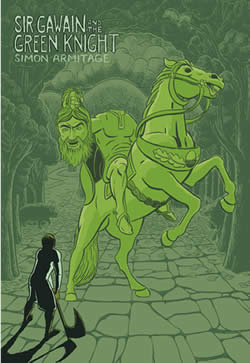 One evening at Camelot King Arthur and his knights were having a feast. All of sudden the doors burst open and in came a fearsome sight - an emerald green knight astride an emerald green steed. He challenged King Arthur's men to chop off his head but whoever did it had submit to having the same done to him one year and one day later. Sir Gawain volunteered and chopped of the head of the Green Knight. The Green Knight then picked up his head and rode off reminding Sir Gawain to meet him in one year and one day in the Green Chapel.
One evening at Camelot King Arthur and his knights were having a feast. All of sudden the doors burst open and in came a fearsome sight - an emerald green knight astride an emerald green steed. He challenged King Arthur's men to chop off his head but whoever did it had submit to having the same done to him one year and one day later. Sir Gawain volunteered and chopped of the head of the Green Knight. The Green Knight then picked up his head and rode off reminding Sir Gawain to meet him in one year and one day in the Green Chapel.
Sometime later Sir Gawain sets out to find the green chapel eventually finding lodging at a hall not far from here (possibly thought to be on the site of Swythamley Hall) with a gentleman known as Sir Bertilak. Sir Bertilak would go out to hunt each day and while he was out Sir Bertilak's wife would try to seduce Sir Gawain but he resisted. On the day before he was due to meet the Green Knight Sir Bertilak's wife gave Sir Gawain a green girdle (a type of belt) as a token of her affection for him and asked for him to keep it a secret.
He heads over to the green chapel and finds the Green Knight in the Green Chapel, the knight indicates that Sir Gawain should kneel down and bend his head forward. Fearfully Sir Gawain does this, the Green Knight swings his axe and misses. He lifts his axe again and yet again misses. For the third time he swings his axe, this time it hits Sir Gawain's neck but just nicks the skin.
Sir Gawain is bewildered but the Green Knight says to Sir Gawain that because he has shown himself to be a man of honour by turning up and also not responding to the attempted seduction that he is free to go. The only reason he sustained the nick to his neck was because he hadn't admitted to having the girdle.
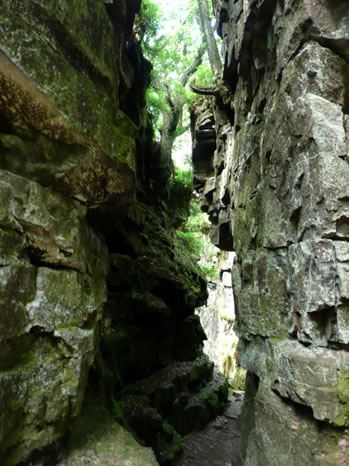 The Green Knight is said to still be sleeping in the Green Chapel . If you pause by the last set steps at the top end of Lud's Church and look back you will see a rock outcrop on the right hand side of the Chasm, this shows a perfect face...take care not to wake him!
The Green Knight is said to still be sleeping in the Green Chapel . If you pause by the last set steps at the top end of Lud's Church and look back you will see a rock outcrop on the right hand side of the Chasm, this shows a perfect face...take care not to wake him!
This is only a very short version of the story. The full version can be read in Sir Gawain and the Green Knight by Simon Armitage(2007). There was also a BBC4 programme on it some time ago. The reason that Lud's church is thought to be the Green Chapel is due to fact that the linguistic root of the poem is on the Staffordshire /Cheshire /Derbyshire border and was possibly penned by a monk at Dieulacres Abbey.
Private Zoo at Roaches Hall.
The origins of the Zoo on the Roaches
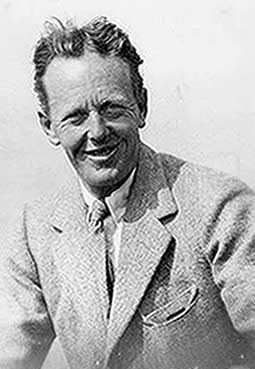 Ask anyone local what they know about Courtney Brocklehurst, what they'll mention first will be the wallabies, and then perhaps the yaks. So where did these come from and why were they on the Roaches?
Ask anyone local what they know about Courtney Brocklehurst, what they'll mention first will be the wallabies, and then perhaps the yaks. So where did these come from and why were they on the Roaches?
We have a great account of them in the Leek Post and Times of 13 Aug 1938 (see below). A reporter had been invited by Courtney to come and have a look. He wrote a glowing report of the conditions they lived in – 'A Staffordshire Utopia':
The animals …'roam freely about the eighty acres of the estate, having all the advantages and none of the disadvantages of life in their native land – an abundance of natural food, shelter from storm and a freedom to travel. It (is)… good to feel that in one part of England at least there exists a sanctuary approaching Eden'.
He mentions many of the animals and birds that were at Roches House: emus, llamas, Sardinian wild sheep, yak, wallabies, black swans, Indian Guinea fowl and a few more besides, but thankfully – he says - no bears and no carnivores.
Courtney had started his zoo in 1936 with animals from Whipsnade. The reporter suggests that it was a sort of outpost of that zoo, in case their stock should be devastated by disease or disaster. This story has been repeated many times, both in the press and on the internet. However when I looked in the archives of the Zoological Society it turned out that Courtney had simply been loaned some of their surplus stock, on the understanding they had a right to half of any offspring (see attached images, which are copies of the minutes of Whipsnade Zoo Management Committee from 13 May 1936 image 1, image 2). It seems it was not uncommon for surplus animals to be passed onto private zoos at that time. There are other examples in the Minutes of the Zoo.
Although the Leek Post reporter found the inmates harmless, it appears not everyone agreed. Many locals remember the yaks and more than one mentions that they used to try and tip vehicles over. Brian Ball of Meerbrook remembers a corn wagon being tipped over and Annie Potter a coal lorry. Rene Turner, the Swythamley Estate manager's wife, remembers the yak licking her car with its big black tongue whilst she was sitting in it – she was desperately afraid she would be knocked over too.
Alan Weeks
Swythamley Historical Society
There was an article written in the Leek Post & Times newspaper on August 13th 1938 about the private zoo at Roaches Hall, Upper Hulme kept by Courtney Brocklehurst. Click this link to see an image of the article. It is quite a large file so may take a while to download. Click
These two pictures were associated with the article.
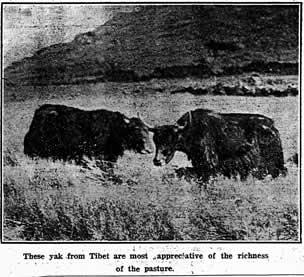
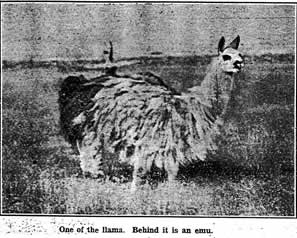
People Threw Stones at the Animals in Courney's Private Zoo
This article was reported in the Hartlepool Mail 25 Aug 1938
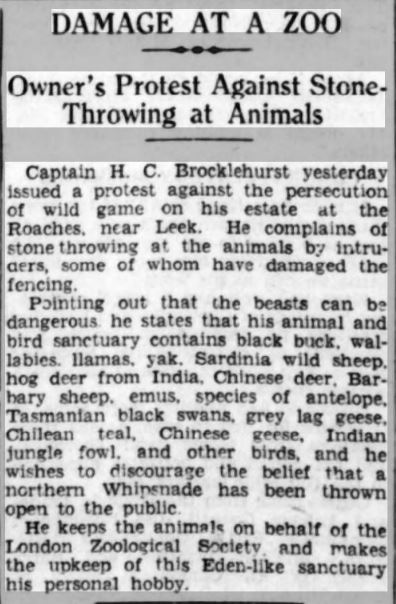
Courtesy of Alan Weeks
Upper Hulme
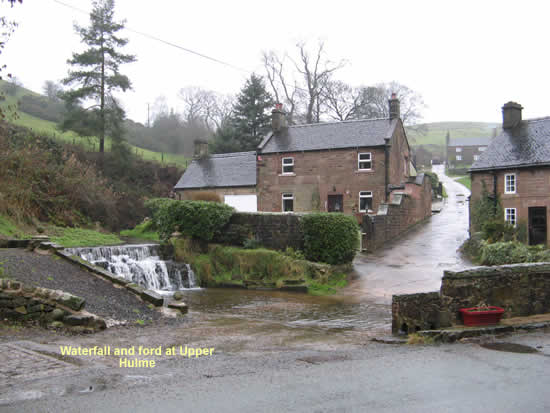
is a hamlet as it has never had a church, though it did have a chapel until about 1999, it's now a holiday cottage, a sign of the times. These days it consists of about 20 houses, a pub - the Olde Rock Inn - and a number of industrial units in what used to be Tatton's - a sizable dying factory.
This is how Henry Wedgewood saw Upper Hulme in 1880. From the Book " Staffordshire - Up and Down the County"
"Another notable place at the foot of the Roches is the village of Upper Hulme. This little hamlet, which consists only of a few houses, lies on the left of the Buxton road. It is situated really in a valley, though some ancient-looking houses stand on the hillside of the picturesque road that leads to the rocks above. Through this dingle-like village a brook of not very broad dimensions makes it’s way, winding between the cottages as it hurries on, impatient to pay its tribute of water to the Churnet that runs through its Frith. The beauty of the scene is increased by a wooden bridge which spans the little stream, although this is only for the accommodation of foot passengers: and horses and vehicles are left to ford the brook. Years ago there used to be a silk factory here; the building is now turned into a dyeing establishment, and the waters of the brook are still used to turn the mill wheel. We should say that Upper Hulme is a happy little village, with work for its few inhabitants, with its village shop and the farms and farm lands stretching around,- it seems perfect in itself. There is one draw back however that mars the picture as far as its completeness goes – there is no village church. No Sabbath morning and evening bells to tell of the sanctity of a day of rest. No ancient tower, no towering steeple, no wayside churchyard where the forefathers of the hamlet sleep. This want takes away much of the joy of a village wedding, and robs the village funeral of much of its simple solemnity. The nearest church to Upper Hulme is Meerbrook, two miles away in a still lower valley. However, on the hillside, just above the brook, as though it were smiling on the cottages below, is a small Wesleyan chapel."
So Upper Hulme has changed very little since 1880 except perhaps is even more deprived in that there is no Chapel or even a post box!! The pub however is thriving.
MEERBROOK
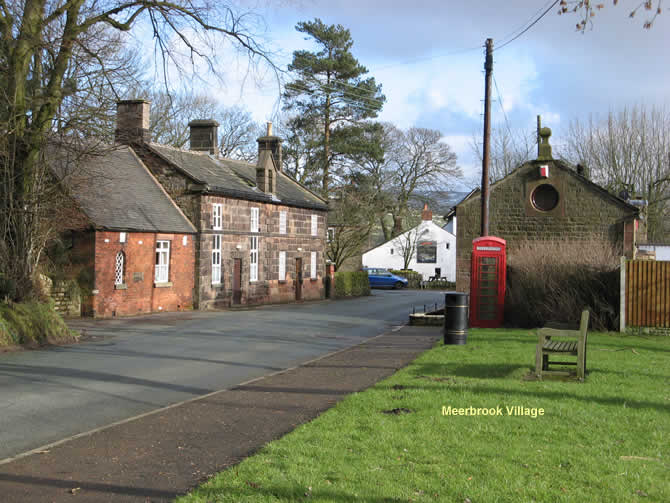
Meerbrook is a tiny village with a pub - the Lazy Trout - , a church, a chapel, a youth hostel that has just closed(Jan 2007), a reservoir which has a visitors centre, a village green and a village hall.
The reservoir flooded the valley in the early 1960's. 9 properties were given up to the water including a pub, which was called the Fountain. A rather prophetic name it seems!
The church - St Matthews is a thriving church still very
much part of the community. There is a service every Sunday
at 11-15am.
According to Mary Breeze, a local historian
" There was a small church here before the dissolution of the monasteries
in1538, belonging to Dieu-la-Cres Abbey, a mile away on the banks of
the River Churnet, and several of the scattered farms were Granges for
the lay brothers."
The present church dates from the 1873.
The Methodist Chapel which is on the right as you enter Meerbrook from the Leek - Buxton rd has Sunday services every fortnight at 2-30pm.
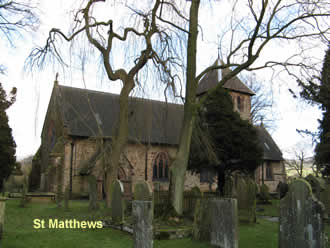
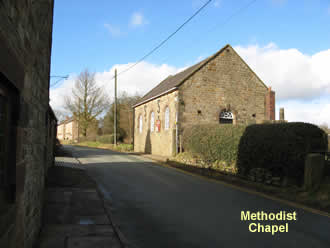
Titterswoth resevoir supplies Stoke-on-trent. At the north end there is a bird hide and plenty of birds to see. We occasionally get a visit from an Osprey. There is a fairly elaborate visitors centre with a few shops and an eatery. There are some pleasant walks around the reservoir.
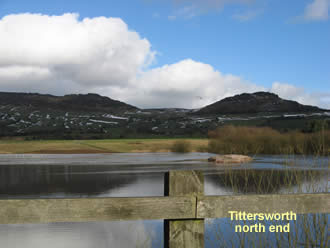
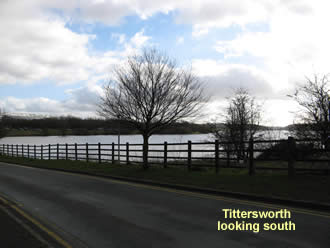
The Lazy Trout is well worth a visit.
Meerbrook Village Hall
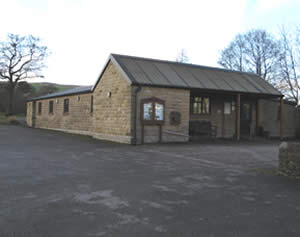
is the centre of many aspects of life in the Roaches
area.
Events
Whist Drive- every other Tuesday
7-45pm
Bingo - every other Tuesday
8pm
Dances 1-2 per month on Friday or Saturday - 8pm
WI second Thursday each month
7-30pm
Also antique fairs and Church functions.
The room is available for rent for Parties, Weddings receptions etc. Contact
Mrs I Goodwin 01538 300543
HISTORY - from a pamphlet wrtten by Mrs W Hine
The Village Hall started in 1908 as the "Public Room". A group
of people were dissatisfied with the dances at the schoolroom because
they were not allowed to dance after midnight. Money for the building
was raised by shares and subscriptions. It was built of tongue and grove
boarding with a corrugated iron roof.
The land was leased for 21 years from Mr John Clulow of Broad Lea farm
at a rent of £1 per year.
There was only an outside loo, lighting was by oil lights and heating
was provided by bringing in paraffin heaters from homes! It was quite
primative but the dancing went on til 2am and after!
When the lease expired in 1929 the shareholders decided to sell up and the Room was bought by a prospective Conservative candidate for the Leek area, Mr Edward Hulton, who donated it to the leek branch of the Primrose League. The Primrose League was an organisation founded in 1883 in memory of Benjamin Disraeli the Tory prime Minister who died in 1881. Click the link for more on the Primrose League. From 1929 to 1953 the Hall was called the Primrose League Room.
During World War 2 the room was deem an Emergency venue and 24 mattresses were stored in a bedroom at New Grange farm. They were never used in anger. Sugar was allowed to the WI for jam making from surplus fruit from gardens and blackberry picking. This was made in the hall and then taken to New Grange farm awaiting a government examiner inspection before it could be sold to shopkeeper's as part of their ration allowance! The resourceful WI even set up a canning operation to can peaches and apples for the locals.
By 1950 the Primrose league had declined in favour of the Conservative associations and in 1953 the Leek branch was disbanded and the room was offered for sale for £50. Mrs GM Nicholson bought the room and donated it to the village of Meerbrook. It now became Meerbrook Village Hall.
Electricity had been installed in 1939 when a supply had finally been laid into the village. In 1955 the Potteries Water board bought land around Meerbrook in preparation for increasing the size of the resevoir. This included the land the Hall stood on. A ground rent of £5 pa was paid.
In 1975 a piped water supply was laid on to Meerbrook and the village well became redundant. Water was at last piped into the village hall rather than shipped in by churns.
The land on which the hall stood was bought from Severn Trent 1983 for £10.
The hall was and is very popular so the decision was made to extend it in 1988.
